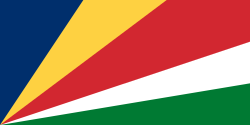 | |
| Use | National flag and ensign |
|---|---|
| Proportion | 1:2 |
| Adopted | 8 January 1996 |
| Design | Five oblique bands of blue, yellow, red, white, and green radiating from the bottom of the hoist side. |
| Designed by | Philip Uzice [1] |
 | |
| Use | President's flag |

The national flag of Seychelles (drapeau national des Seychelles) was adopted on 8 January 1996. [2] The current flag is the third used by the country since its independence from the United Kingdom on 29 June 1976. [3] The colours used in the current flag are the official colours of two of the country's major political parties: the Seychelles People's United Party and the Seychelles Democratic Party.







